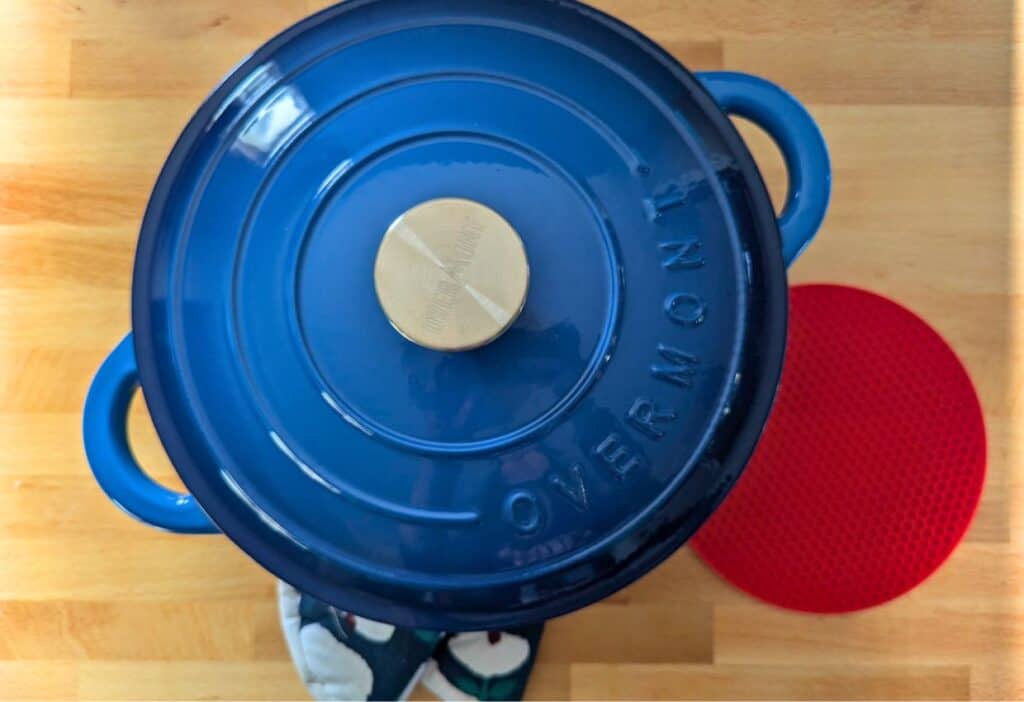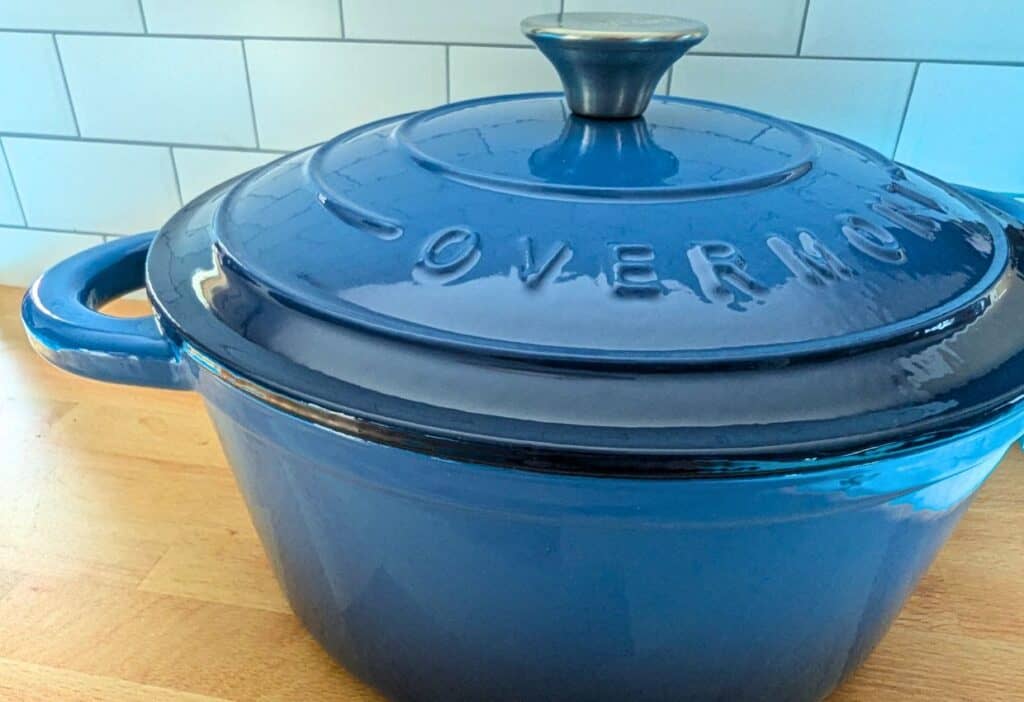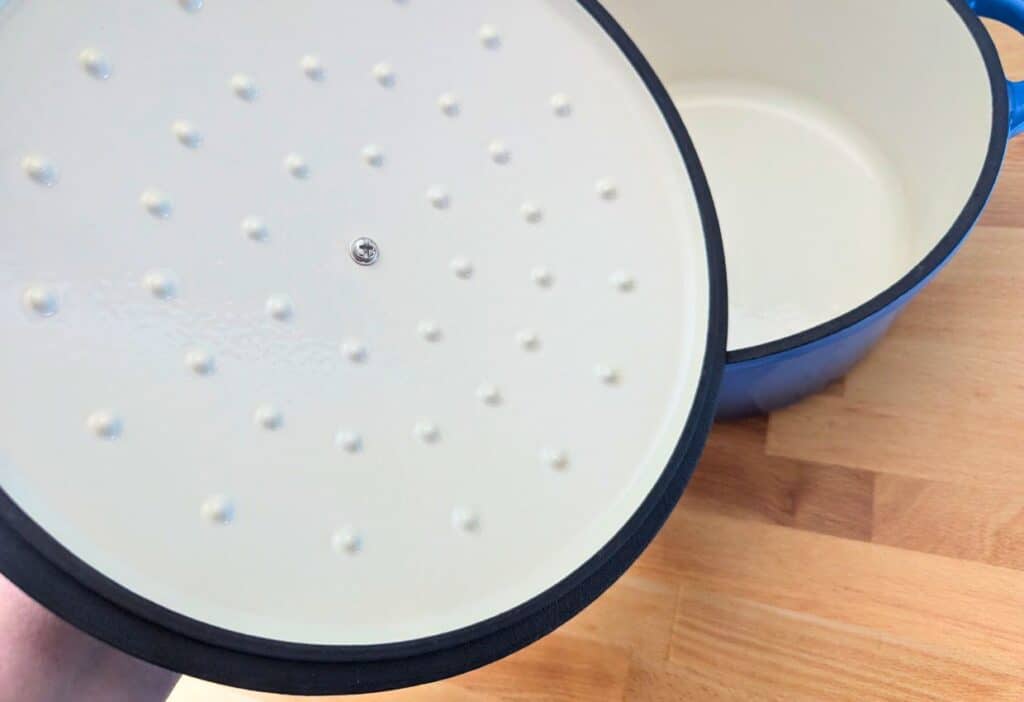Enameled cast iron cookware has long been a staple in kitchens worldwide, praised for its durability, versatility and beauty. But do you really need to splurge on a premium brand like Le Creuset, or can you get the same performance from less expensive alternatives?

This post may contain affiliate link(s). As an Amazon Associate, I earn from qualifying purchases. See Disclosures.
Why you’ll love using enameled cast iron
Enameled cast iron is the workhorse of cookware and for good reason. It combines the best of two worlds: The even heat retention of traditional cast iron and the easy-to-clean surface of enamel coating. It’s the perfect pot to choose whether you’re searing meats, slow-cooking stews or baking bread.
Enameled cast iron works on virtually every heat source from gas stoves to induction cooktops, and it transitions seamlessly from stovetop to oven. The enamel coating prevents rust and eliminates the need for seasoning, which traditional cast iron requires. Plus, its aesthetic appeal means you can serve your dish directly from the pot, so you have to dirty one less dish while still having your tablescape look great.
Enameled cast iron also has staying power. When cared for properly, it can last for decades, making it a worthwhile investment for avid home cooks. This durability is part of why brands like Le Creuset have built such a loyal following — but is the price tag truly justified?
What is enameled cast iron?
Enameled cast iron has a cast iron base coated with a layer of enamel, which is a type of glass fused to the metal at high temperatures. This enamel serves as a protective layer, so you don’t have to worry about cast iron rust and it has much easier cleanup. Enameled cast iron is low-maintenance and non-reactive, meaning you can cook acidic foods like tomato sauces without worry.
French brands, most notably Le Creuset, became pioneers in this space, turning the material from a utilitarian kitchen tool to a status symbol. Over time, enameled cast iron gained popularity worldwide, thanks to its durability, vibrant color options and reputation for delivering consistent cooking results. However, Le Creuset pots often cost $300 or more per pot, depending upon the size.
In the past 10 years, many manufacturers started offering similar products at a fraction of the price, making them more accessible to home cooks. While the basics remain the same — cast iron covered with enamel — there are some differences in quality that are worth considering.
What you should look for in quality cast iron
When shopping for enameled cast iron, there are a few key factors to keep in mind to ensure you’re getting a quality product. The first is weight. A good enameled cast iron pot should feel heavy, indicating solid construction and superior heat retention. Lightweight options may seem more convenient, but they often sacrifice performance and can result in scorched foods or become prone to rust down the line.
The enamel coating should be smooth, even and free from chips or cracks. Poorly applied enamel can wear down over time, exposing the cast iron underneath and potentially leading to rust. A high-quality enamel coating will withstand decades of use without significant wear.
Pay attention to the lid and handles as well. A tight-fitting lid is crucial for recipes that require moisture retention, like braises and stews. Handles should be sturdy and easy to grip, as enameled cast iron cookware is often heavy, even when empty. Look for features like loop handles or ergonomic designs that make maneuvering easier.
Finally, consider the size and shape of the cookware. A 5- to 7-quart Dutch oven is versatile enough for most households, while specialty shapes like oval cocottes or smaller sizes may be better suited to specific cooking like making homemade caramel or savory sauces.
Why you don’t have to buy Le Creuset anymore
Le Creuset has long been the gold standard for enameled cast iron and there’s no denying its reputation for quality and craftsmanship. But in recent years, the new alternatives are often just as durable, functional and stylish, making them an excellent choice for budget-conscious cooks.
Even big-box retailers like Target and Amazon have introduced their own lines of enameled cast iron, providing budget-friendly options that don’t skimp on style or utility. You can find various brands online that you may not have heard of before, such as Overmont, that include new features like self-basting lids and come with heat-resistant caps to help reduce the chance of burns.
The question of whether to buy Le Creuset often comes down to personal preference and priorities. If you value brand names and a product made in France, Le Creuset may still hold appeal. It also offers a wider variety of sizes and shapes and complementary accessories than other brands.
However, for those who prioritize functionality over status, less expensive brands can offer an equally satisfying cooking experience without the hefty price tag. Many brands also now offer a wide range of colors from forest green to pumpkin to sapphire blue and more.
Overmont is a lesser-known brand worth purchasing
Overmont bakes three layers of enamel onto their pots, which ensures that they have a smooth finish that will last. While they don’t have quite the variety of sizes and shapes that Le Creuset does, they offer the standard pots that a home cook typically purchases.

The line includes a variety of sizes of Dutch ovens, which is the most common shape, as well as braisers. You have your choice of a variety of different and vibrant colors to coordinate with your kitchen easily.
The inside of the lids come with little spikes that ensure the steam collects and then drips back onto your food, creating a basting effect when the lid is in place. Cleaning your cast iron is just as easy or possibly even more so when using an Overmont Dutch oven than a Le Creuset enameled cast iron pot.
“I love the cast iron lids that have the unique spikes on the inside. They help steam condense and drip back onto the food, creating a natural basting effect. It’s a simple yet brilliant design feature that has helped me elevate everything from soups to roasts!”
— Shruthi Baskaran-Makanju, Urban Farmie

Many of the Dutch ovens now come with a flat lid rather than the mushroom-shaped lid you’re used to seeing. This lid shape is intended to help quickly cool your dish when you place ice cubes on it, maximizing tenderness and moisture in the meats you cook.
The actual pot weighs almost exactly the same as a Le Creuset of the same variety. It is made with quality materials that will heat evenly and not cheaper and lighter metals that prevent your cooking from turning out as well as it could.
The price is the big differentiator between the big brand name and Overmont. An Ovemont Dutch oven costs approximately $60 to $90, depending upon the size and color, compared to over $350 for a Le Creuset Dutch oven.
Go ahead and buy the less expensive cast iron
Enameled cast iron is a kitchen staple for a reason: It’s versatile, durable and adds a touch of charm to any meal. While Le Creuset has earned its place as a leader in the market, it’s no longer the only option for home cooks seeking high-quality enameled cast iron cookware. With so many great options available, there’s no need to break the bank to enjoy the benefits of enameled cast iron.
Michelle Price is a food and travel writer at Honest and Truly who almost has an empty nest. She loves to provide both the inspiration and the confidence you need to help get you into the kitchen and on the road to enjoy new flavors and experiences.